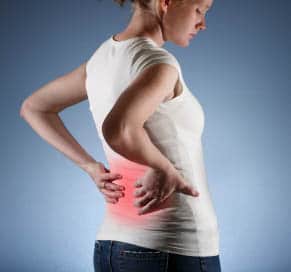 Low back pain is a common musculoskeletal disorder, affecting 80% of people at some point in their lives. In North America it is the most common cause of disability, a leading contributor to missed work, and the second most common neurological ailment (See reference 1).
Low back pain is a common musculoskeletal disorder, affecting 80% of people at some point in their lives. In North America it is the most common cause of disability, a leading contributor to missed work, and the second most common neurological ailment (See reference 1).
What causes low back pain?
The vast majority of episodes are the result of benign musculoskeletal problems, and are referred to as "non-specific". This type may be due to muscle, ligament or joint sprains or strains. However, there are also many non-musculoskeletal causes, that may or may not require medical care. For this reason, if you are experiencing back pain that is not going away on its own, a visit to your healthcare provider is very important.
The healthcare professionals at Able Body Health Clinic are experts in the assessment of low back pain and can advise you on your treatment options, or tell you if your condition requires a visit to your medical physician.
How can low back pain be treated?
Depending on the cause, most cases will resolve on their own in 1-3 months; however, some cases may not resolve themselves if ignored (See reference 2). Up to 30% of cases will still not be recovered after one year (See reference 3).
For many people, there are treatments that can shorten the recovery time and reduce the likelihood that the pain will come back:
Chiropractic care is the most effective and most researched therapy for low back pain!
What does the public say? The 2011 Consumer Reports Overview of Alternative Therapies rated chiropractic the most effective treatment for back pain. Moreover, the 2009 Consumer Reports Health Ratings Center survey found that chiropractic was the most satisfying treatment available overall.
What does the research say? A 2010 review found that spine manipulation achieves equal or superior improvement in pain and function than all other commonly used treatments (See reference 4).
What do medical doctors say? In 2007 the American College of Physicians and the American Pain Society jointly recommended that spine manipulation be considered for people who do not improve on their own (See reference 5).
Other non-surgical treatments
*Note: These therapies are available at Able Body Health Clinic. The health care professionals at Able Body Health Clinic can tell you which therapies are safe and effective depending on your specific condition.
• Rehabilitative exercises and specific activity recommendations – Engaging in physical activity within the limits of your pain can speed recovery if done correctly. Specific stretching and strengthening can help to restore motion and strength and can be very helpful in relieving pain and preventing future episodes.
• Physical modalities – These therapies can offer short-term pain relief and include ultrasound and electrical stimulation.
• Acupuncture – Acupuncture can offer significant relief of chronic low back pain (See reference 6).
• Massage Therapy – Massage therapy can also offer significant relief (See reference 7).
What about medications or surgery?
*Note, while the health care professionals at Able Body Health Clinic can provide you with information regarding your pharmaceutical and surgical options for back pain treatment, you should never start taking any new medications without the advice of your pharmacist or medical physician.
• Medication – According to the American Pain Society/American College of Physicians clinical practice guideline, medications with good evidence of short-term effectiveness for low back pain are NSAIDs, acetaminophen, skeletal muscle relaxants (for acute pain), and tricyclic antidepressants (for chronic pain). Evidence is insufficient to identify one medication as offering a clear overall net advantage because of complex tradeoffs between benefits and harms (See reference 8).
• Surgery – Surgery is sometimes necessary for some people, such as those with spinal instability or progressive neurological deficits; however, both surgery and overtreatment with conservative therapies should be avoided when possible (See reference 9).
References
1) National Institute of Health. “Lower Back Pain Fact Sheet. nih.gov”. Retrieved 2012-03-16. http://www.ninds.nih.gov/disorders/backpain/detail_backpain.htm
2) Hestbaek L, Leboeuf-Yde C, Manniche C. Low back pain: what is the long-term course? A review of studies of general patient populations. Eur Spine J. 2003;12(2):149-65.
3) Henschke N, Maher CG, Refshauge KM, Herbert RD, Cumming RG, Bleasel J, York J, Das A, McAuley JH. Prognosis in patients with recent onset LBP in Australian primary care: inception cohort study. BMJ. 2008 Jul 7;337:a171.
4) Dagenais, S; Gay, RE; Tricco, AC; Freeman, MD; Mayer, JM. “NASS Contemporary Concepts in Spine Care: spinal manipulation therapy for acute LBP”. The spine journal : official journal of the North American Spine Society. 2010;10(10): 918–40.
5) Chou R, Qaseem A, Snow V et al. “Diagnosis and treatment of LBP: a joint clinical practice guideline from the American College of Physicians and the American Pain Society”. Ann Intern Med. 2007;147 (7):478–91.
6) Trigkilidas D. Acupuncture therapy for chronic LBP: a systematic review. Ann R Coll Surg Engl. 2010 Oct;92(7):595-8.
7) Cherkin DC, Sherman KJ, Kahn J, Wellman R, Cook AJ, et al. A comparison of the effects of 2 types of massage and usual care on chronic LBP: a randomized, controlled trial. Ann Intern Med. 2011 Jul 5;155(1):1-9.
8) Chou R, Huffman LH; American Pain Society; American College of Physicians. Medications for acute and chronic LBP: a review of the evidence for an American Pain Society/ American College of Physicians clinical practice guideline. Ann Intern Med. 2007 Oct 2;147(7):505-14.
9) Balagué F, Mannion AF, Pellisé F, Cedraschi C. Non-specific LBP. Lancet. 2012 Feb 4;379(9814):482-91.
